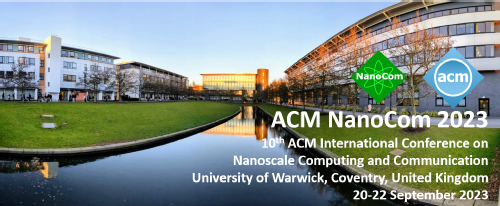News
Dr Hamidreza Arjmandi Promoted to Assistant Professor
We're very pleased to share that Dr Hamidreza Arjmandi has been promoted to Assistant Professor (Research Focused). Hamidreza has been a valuable member of our group for the last 18 months and this promotion is a great recognition of his many research contributions, plus his commitment to service and teaching.

New CFP - Molecular Communication in Crowded and Multi-Cellular Environments
- Signal propagation models designed for intercellular environments such as organoids, tissues, organs, tumors, and biofilms
- Signal propagation models designed for intracellular environments such as cytoplasm, nuclei, and organelles
- Signal propagation models designed for crowded environments (biological or non-biological) such as porous media
- Unconventional diffusion modeling, including anisotropic diffusion, anomalous diffusion (superdiffusion or subdiffusion), fractional Brownian motion, and multi-phase diffusion
- Biophysical flow modelling, including turbulent and laminar flow
- Multi-cellular chemical reaction networks
- Design of synthetic or natural communication systems in multi-cellular environments
- Communication system analysis in multi-cellular environments
- Decentralized cellular decision-making and computation
- Experimental methods to apply or detect signals in multi-cellular environments, either in aggregate or at single-cell resolution
Paper Accepted: Diffusive Molecular Communication with a Spheroidal Receiver for Organ-on-Chip Systems
Our paper "Diffusive Molecular Communication with a Spheroidal Receiver for Organ-on-Chip Systems" was accepted for presentation at IEEE ICC this May in Rome, Italy. This paper will be our group's first publication focused on organ-on-chip systems. We model an organoid of cells as a receiver and derive the channel response from a nearby point transmitter. We approximate the porous organoid receiver as a sphere with a lower diffusion coefficient and show its impact on the received signal. This paper was co-authored with Hamidreza Arjmandi and Mitra Rezaei from our group, in addition to Mohamad Zoofaghari (Yazd University, Iran) and our SIMBA project collaborators at AstraZeneca Sweden (Kajsa Kanebratt, Liisa Vilen, David Janzen, and Peter Gennemark).
Hosting Conference - 2023 ACM NanoCom

We're pleased to announce that we will be hosting the 10th ACM International Conference on Nanoscale Computing and Communication (ACM NanoCom) here at the University of Warwick. The conference will be held from 20-22 September, 2023. Adam Noel is serving as General Chair along with Andrew Eckford (York University, Canada). Other local organisers include Hamidreza Arjmandi as Local Organization Chair, Matthew Higgins as Sponsorship Chair, and Yanahan Paramalingam as Social Media Chair.
ACM NanoCom 2023 is endorsed by the Technical Committee on Molecular, Biological, and Multi-Scale Communications of the IEEE Communications Society.
The Call for Papers is now available. Full details can be found here. The initial deadline for Regular Papers is 9 April 2023.
New Visiting Research Fellow - Dr Ibrahim Isik
We're pleased to welcome Dr Ibrahim Isik who joins us as a Visiting Research Fellow to work on fluid dynamics and signal transport for bacteria. Ibrahim has a B.Sc. in Electrical Electronics Engineering from the University of Gaziantep, Turkey, and both an M.Sc. and Ph.D. in Electrical Electronics Engineering from Inonu University, Turkey. His Ph.D. research was on the impact of amyloid beta on molecular communication.

New PhD Scholarship Student: Mitra Rezaei
We're pleased to welcome Mitra Rezaei who joins us with a Chancellor's International Scholarship to do her PhD on communication between cell organoids. Mitra has a B.Sc. in Biomedical Engineering from Sahand University of Technology and an M.Sc. in Biomedical Engineering from Tarbiat Modares University.

Paper Accepted: Membrane Fusion-Based Transmitter Design for Static and Diffusive Mobile Molecular Communication Systems
Our paper "Membrane Fusion-Based Transmitter Design for Static and Diffusive Mobile Molecular Communication Systems" (alternative arXiv link) was accepted for publication in IEEE Transactions on Communications. This paper considers a novel molecular communication system where the transmitter is a membrane-bound sphere and vesicles bind to and fuse with the sphere in order to release molecules into the propagation environment. Such a system is more reflective of cellular signalling than the point- or volume-based transmitters that are usually modelled. We derive the resulting molecule release probability and the corresponding impact on what is observed at an absorbing receiver. Our simulation results show how the hitting probability at the receiver is impacted by slow vesicle diffusion or a low membrane fusion probability. The paper was co-authored with Xinyu Huang (Australian National University), Yuting Fang (Melbourne, Australia), and Nan Yang (Australian National University).
Group Update: New Research Members in 2021
We're pleased to welcome the new research members that have joined the BioPhysComm Lab this year.
Dr Hamidreza Arjmandi joins us as a Research Fellow to work on the SIMBA Project (Signal Propagation and Information in Microscale Biological Applications). Dr Arjmandi was previously an Assistant Professor at Yazd University, Iran, and an ERCIM Postdoctoral Fellow at Norwegian University of Science and Technology. He completed his PhD in Electrical Engineering from Sharif University of Technology (Tehran, Iran) in 2016.
 Dr Hamidreza Arjmandi
Dr Hamidreza Arjmandi
We're also pleased to welcome 2 new PhD students: Yanahan Paramalingam and Mahir Taher. Yanahan is co-supervised by Freya Harrison and Tara Schiller, and is studying signalling within biofilms. Mahir joins us as a member of the Interdisciplinary Biomedical Research PhD Program. He is co-supervised by Anne Straube and is studying molecular transport in neurons.
 Yanahan Paramalingam
Yanahan Paramalingam
 Mahir Taher
Mahir Taher
Position Available: Research Fellow for EPSRC Project “Signal Propagation and Information in Microscale Biological Applications (SIMBA)”
We have a 2-year postdoctoral position for a Research Fellow to work on the EPSRC project "Signal Propagation and Information in Microscale Biological Applications (SIMBA). This project includes collaboration with Dr Christophe Corre in the School of Life Sciences and with AstraZeneca. Applications close 22 June 2021 and can be made here.
Posted to arXiv: Membrane Fusion-Based Transmitter Design for Static and Diffusive Mobile Molecular Communication Systems
Our paper "Membrane Fusion-Based Transmitter Design for Static and Diffusive Mobile Molecular Communication Systems" has been posted to arXiv. This paper considers a novel molecular communication system where the transmitter is a membrane-bound sphere and vesicles bind to and fuse with the sphere in order to release molecules into the propagation environment. Such a system is more reflective of cellular signalling than the point- or volume-based transmitters that are usually modelled. We derive the resulting molecule release probability and the corresponding impact on what is observed at an absorbing receiver. Our simulation results show how the hitting probability at the receiver is impacted by slow vesicle diffusion or a low membrane fusion probability. The paper was co-authored with Xinyu Huang (Australian National University), Yuting Fang (Melbourne, Australia), and Nan Yang (Australian National University).
